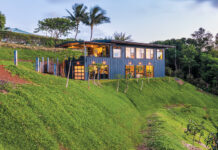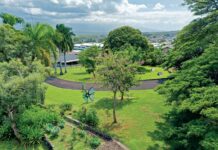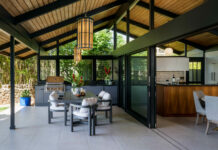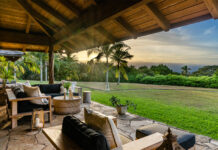Story by Teya Penniman
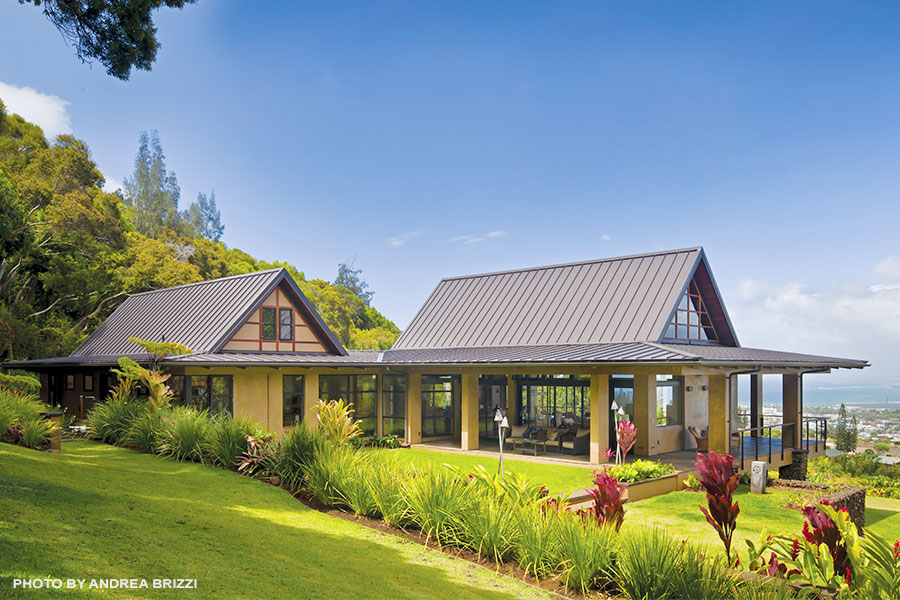
It’s a delight to be an architect on Maui, because there are so many microclimates, making each project a unique challenge,” says Jim Niess, who’s designed Maui homes for more than forty years. “There are few places in the world where we can live in the climate, where we don’t have to struggle against it.”
True — to a certain extent. Ancient Hawaiians lived mostly outdoors; they built their homes from thatch of pili grass and hala (pandanus) — plant materials that may not have lasted long, but were easily replaced. In contrast, the missionaries and business people who settled in Hawai‘i in the 1800s built structures more attuned to their New England roots than to the Islands’ subtropical climate. It wasn’t until the early twentieth century that the Islands’ leading architects began to design spaces that again spoke to the local environment, a style that blurred the distinction between interior and exterior.
But our paradisiacal climate can be other than benign. Sun, wind, rain and introduced critters can reduce our grand edifices to piles of rocks, rotting timber, and a list of coulda/shouldas. What are the greatest challenges to “living in the climate” on Maui? What can homeowners do to protect their investments?
For local expertise, I turned to Niess, president of Maui Architectural Group, and Jeff Anselm, owner of Home Buyers Inspection Service, who has three decades’ experience in building and inspection. Both emphasized the importance of site characteristics — a solution for one house might not work elsewhere — and they shared advice about how to protect your home from the elements.
Sun & Heat
Lahaina means “cruel sun” but it’s not the only locale that toasts under the rays of our local star. “Your roof is your first line of protection,” Anselm says. Installed correctly, fiberglass-asphalt shingles should last twenty-five years, but excessive sun can warp, split and weaken shingles. Regular inspection and replacement will help ensure your roof’s integrity. He likes concrete roof tiles; they’re more expensive but transfer less heat and stand up better to high wind and rain. If used on the windward side, they require more frequent power washing to remove moss or mildew. And there’s a trick to walking on them: keep your weight on the leading edges, where the tiles overlap, to minimize breakage.
Niess says aluminum-zinc roofs are lightweight, durable, and an excellent option for catchment if you’re not connected to the County water system. They are also good for photovoltaic installations. He recommends shade plantings to reduce heat; and passive solar design, such as proper orientation, insulation, ventilation and reflective roofs, to heat or cool living spaces. To get the best of both worlds, solar panels can be installed on lanai roofs that shade the sunny side of a house. Raised floors, floor and ceiling vents, jalousies with hoods, and window and door placements that create low-pressure areas in the house will help lure cooling breezes inside.
Wind
Maui can be a breezy place, with the trades bumping up against our two volcanoes and kona winds bringing southerly storms. Where you live (windward or leeward) and your home’s orientation affect your vulnerability, but with no guarantees. Tropical storm Iselle demolished structures at Upcountry’s ‘Ulupalakua Ranch, while buildings less than a mile away escaped unscathed. Major damage has been rare on Maui, but correct spacing of hurricane clips, appropriate sizing of overhangs, and regular roof inspections and tree-branch trimming will help your house weather most wind events.
Both gentle sea breezes and gusty gales can carry other modes of destruction.
Salt Spray & Dust
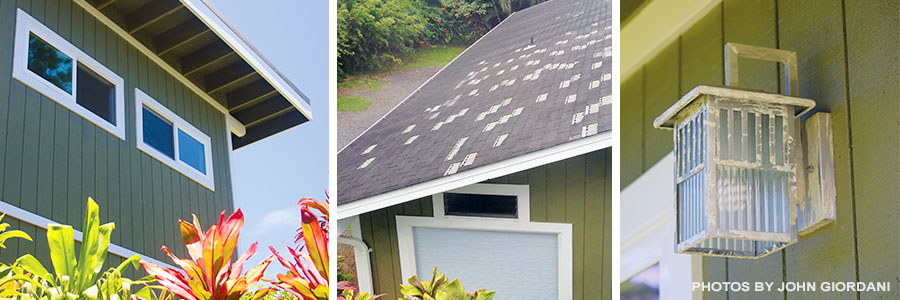
In a paean to rust, former Maui author Tom Stevens wrote, “Rust didn’t have a lot to do in pre-metallic Hawai‘i. [Its] only job in those days was to turn the dirt red.” Not so today. Iron and other metal-based products such as screws, bolts, and nails exposed to salt- and moisture-laden winds can become pupu (snacks) for corrosion. Electrical mains and meters installed on the windward side are easy prey. Both my experts extolled the virtues of stainless steel, recommended eliminating fastener exposure wherever possible, and warned against contact between dissimilar metals, which creates a breeding ground for corrosion. Rusty fasteners can cause paint cracking and vice versa. Anselm advises against using aluminum windows, ever, preferring corrosion-resistant vinyl, and Niess observes, “We wash our dogs, we wash our cars, we wash our bodies, but for some reason we don’t wash our houses.” He recommends an annual pressure washing, post winter, to remove salt and dust accumulations. Anselm cautions DIY types to be sure they don’t spray water into wall spaces.
Air pollution is not a recent development in the Islands. The Hawaiian saying Ka makani hapala lepo o Pa‘ia means “the dust-smearing wind of Pa‘ia.” Anselm says clogged scupper drains can cause red-dirt streaks on walls. It’s mostly a cosmetic issue, but eventually you’ll need to repaint. Dust-filled puka(holes) also capture moisture and feed rust. Niess says, “Don’t put a window where you can’t wash it.”

Humidity
In north-shore kitchens, you can practically watch salt crystals clump in unprotected shakers as moisture-bearing winds blow through the house. More problematic is the development of mold and mildew, common on wood cabinets and in bathrooms. Wood that retains moisture for too long requires surgery to remove both the rotten piece and a one-foot buffer. Most of the serious mold problems Anselm encounters come from unnoticed plumbing leaks. Options for reducing fungi in your life include improved airflow design, use of fans and dehumidifiers when moisture levels are high, and moving to Wailea.
Termites
Muggy weather is hard on our homes for another reason: termites need calm, humid nights for the swarms (winged adults) to emerge, mate and establish new colonies. Of the seven or more species in Hawai‘i, two cause the most damage; economic costs for the Formosan subterranean termite are pegged at more than $100 million annually.
How do you know if you have termites? Look for frass and tubes. Drywood termites excrete sand-sized droppings, or “frass,” outside the wood, then close up their lua (bathroom) holes. They eat in any direction, both across and with the grain. The Formosans build mud tubes along boards, in wall spaces, and between the ground and structure; their culinary preference is for softer areas, following the grain and leaving behind wooden skeletons. Other possible signs are paint blisters, roof leaks, door sags and electrical problems.
Your house design should isolate wood from the soil. Basaltic gravel below the footings can be used as a physical barrier. Most lumber in Hawai‘i is pressure treated with a borate solution to protect against termites. Anselm recommends painting or dipping wood in a borate solution after any saw cuts. Steel framing is another option. Spot treatments may stop small infestations, but if the damage is extensive, fumigation or “tenting” is necessary — just another feature of “living in the climate.”
In addition to the specific solutions my experts offered, a few key points kept resurfacing:
Design it and build it right. Be informed and engaged. Ask your architect and builder how the proposed design and materials will maximize your home’s resilience to weather and insects.
Manage airflow. Good airflow helps maintain optimum temperatures. Make sure you address humidity if that’s an issue for your area.
Keep it clean. Pressure-wash the exterior of your house each spring.
Keep a watchful eye. Unless you are an industry insider, consider hiring a professional to inspect your Maui house every two years.

